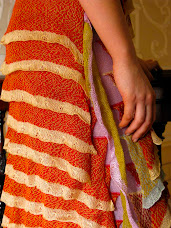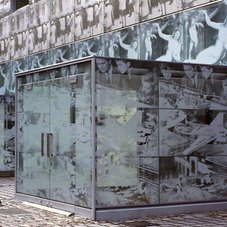Don't be concerned, the following actually does segue into less is more green. Techniques for body ornament, such as piercing and tattooing have been applied to architecture since the inception of modernism. The Library at the Eberswalde Technical School in the former DDR (East Germany), designed by Herzog & de Mueron is a contemporary example. The project consists of bands of concrete alternating with glass, which have windows. Doors occasionally pierce the walls of this small but elegant structure. According to Herzog, “The Eberswalde Technical School Library is a collaboration with [artist] Thomas Ruff, who collects photographs from magazines and newspapers, frames and exhibits them. The concept of tattooing a body is an archaic means of decoration, an issue which I find alluring.” He remarked that Adolf Loos' Ornament und Verbrechen (Crime Against Ornament, a collection of essays published in 1908) was totally unappealing to him and that the desire to ornament is a human tendency. Austrian architect, Loos, despised applied ornament and advocated the use of materials instead, well illustrated by the 1928 Müller Villa in Prague.
Crime Against Ornament proposed the theory that the use of applied or superficial ornament was the result of criminal degeneration. Directing his tirade at Secession architects such as Henry van de Velde, who designed houses, housewares, hardware, and even his wife’s dresses, Loos believed ornament should derive from the materials used for construction, not the economically enslaved populace who produced ornament. This ethical position would seem to coincide with Herzog’s own use of materials evinced in the Tate Modern.
Loos was openly derisive of one of the last decorative styles at the end of the 19th century, the Secessionist movement. Not only did Loos design extraordinary houses he was equally involved with fashion, editing a men’s fashion journal for a brief period. To illustrate the Secession’s obsession with designing every facet of life he related this anecdote, “Once it happened that [a client] was celebrating his birthday. His wife and children had given him many presents. He liked their choice[s] immensely and enjoyed it all thoroughly. But soon the architect arrived... He entered the room. The master greeted him with pleasure... But the architect did not see the man’s joy. He had discovered something quite different and grew pale. ‘What kind of slippers are these you’ve got on?’ he ejaculated painfully. The master of the house looked at his embroidered slippers. Then he breathed in relief. This time he felt quite guiltless. The slippers had been made to the architect’s original designs. So he answered in a superior way, ‘But Mr. Architect! Have you already forgotten? You yourself designed them.’ ‘Of course’ thundered the architect, ‘but for the bedroom! They completely disrupt the mood here with these two impossible spots of colour. Can’t you see that?’”
The alternating glass and concrete bands of the Eberswalde Technical School Library allude to similar bands of glass, cladding material, and steel of skyscraper construction. The basis for modern architecture is not only the series of engineering feats originating during the late 19th century in Chicago, but an ethical position, not unrelated to the current emphasis on sustainable living. Minimalism in architecture and design continues to be a viable strategy and ecomodista even advocates minimal consumption.
Peter Gluck is the first architect to receive a LEED Silver rating for an affordable housing project, Little Ajax in Aspen, Colorado. Gluck designed the Kaplan Residence in Chicago, using a melange of materials, wood, copper, and stainless steel in this opulent, but minimalistic home.
Crime Against Ornament proposed the theory that the use of applied or superficial ornament was the result of criminal degeneration. Directing his tirade at Secession architects such as Henry van de Velde, who designed houses, housewares, hardware, and even his wife’s dresses, Loos believed ornament should derive from the materials used for construction, not the economically enslaved populace who produced ornament. This ethical position would seem to coincide with Herzog’s own use of materials evinced in the Tate Modern.
Loos was openly derisive of one of the last decorative styles at the end of the 19th century, the Secessionist movement. Not only did Loos design extraordinary houses he was equally involved with fashion, editing a men’s fashion journal for a brief period. To illustrate the Secession’s obsession with designing every facet of life he related this anecdote, “Once it happened that [a client] was celebrating his birthday. His wife and children had given him many presents. He liked their choice[s] immensely and enjoyed it all thoroughly. But soon the architect arrived... He entered the room. The master greeted him with pleasure... But the architect did not see the man’s joy. He had discovered something quite different and grew pale. ‘What kind of slippers are these you’ve got on?’ he ejaculated painfully. The master of the house looked at his embroidered slippers. Then he breathed in relief. This time he felt quite guiltless. The slippers had been made to the architect’s original designs. So he answered in a superior way, ‘But Mr. Architect! Have you already forgotten? You yourself designed them.’ ‘Of course’ thundered the architect, ‘but for the bedroom! They completely disrupt the mood here with these two impossible spots of colour. Can’t you see that?’”
The alternating glass and concrete bands of the Eberswalde Technical School Library allude to similar bands of glass, cladding material, and steel of skyscraper construction. The basis for modern architecture is not only the series of engineering feats originating during the late 19th century in Chicago, but an ethical position, not unrelated to the current emphasis on sustainable living. Minimalism in architecture and design continues to be a viable strategy and ecomodista even advocates minimal consumption.
Peter Gluck is the first architect to receive a LEED Silver rating for an affordable housing project, Little Ajax in Aspen, Colorado. Gluck designed the Kaplan Residence in Chicago, using a melange of materials, wood, copper, and stainless steel in this opulent, but minimalistic home.







